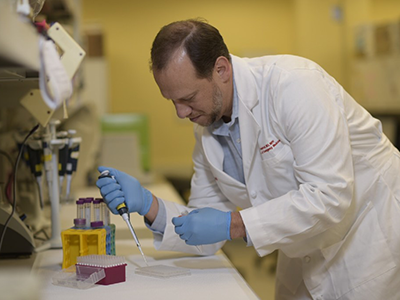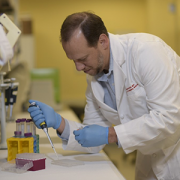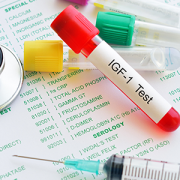Detecting early signs of type 2 diabetes through microRNA

Obesity is a major risk factor for insulin resistance and type 2 diabetes. Now researchers understand the pathogenesis better among teens with mid-level obesity, thanks to clues released from circulating adipocyte-derived exosomes.
Researchers know that exosomes, tiny nanoparticles released from fat cells, travel through the bloodstream and body, regulating a variety of processes, from growth and development to metabolism. The exosomes are important in lean, healthy individuals in maintaining homeostasis, but when fat gets ‘sick’ – the most common reason for this is too much weight gain – it can change its phenotype, becoming inflammatory, and disrupts how our organs function, from how our skeletal muscle and liver metabolize sugar to how our blood vessels process cholesterol.
Robert J. Freishtat, M.D., M.P.H., the chief of emergency medicine at Children’s National Health System and a professor of precision medicine and genomics at the George Washington University School of Medicine and Health Sciences, and Sheela N. Magge M.D., M.S.C.E., who is now the director of pediatric endocrinology and an associate professor of medicine at the Johns Hopkins School of Medicine, were curious about what this process looked like in teens who fell in the mid-range of obesity.
Obesity is a major risk factor for insulin resistance and type 2 diabetes, but Dr. Freishtat and Dr. Magge wanted to know: Why do some teens with obesity develop type 2 diabetes over others? Why are some teens in this mid-range of obesity metabolically healthy while others have metabolic syndrome? Can fat in obese people become sick and drive disease?
To test this, Dr. Freishtat and Dr. Magge worked with 55 obese adolescents, ages 12 to 17, as part of a study at Children’s National. The participants – 32 obese normoglycemic youth and 23 obese hyperglycemic youth – were similar in age, sex, race, pubertal stage, body mass index and overall fat mass. The distinguishing factor: The hyperglycemic study participants, the teens with elevated blood sugar, differed in where they stored fat. They had extra visceral fat (or adipose tissue) storage, the type of fat that surrounds the liver, pancreas and intestines, a known risk factor for type 2 diabetes.
Dr. Magge and Dr. Freishtat predicted that circulating exosomes from the teens with elevated blood sugar are enriched for microRNAs targeting carbohydrate metabolism.
They used three tests to examine study participants’ metabolism, body composition and circulating exosomes. The first test, an oral glucose tolerance test, measures how efficiently the body metabolizes sugar; the second test is the whole body DXA, or dual-energy x-ray absorptiometry, which analyzes body composition, including lean tissue, fat mass and bone mineral density; and the third test, the serum adipocyte-derived exosomal microRNA assays, is an analysis of circulating fat signals in the bloodstream.
They found that teens with elevated blood sugar and increased visceral fat had different circulating adipocyte-derived exosomes. These study participants’ exosomes were enriched for 14 microRNAs, targeting 1,304 mRNAs and corresponding to 179 canonical pathways – many of which are directly associated with carbohydrate metabolism and visceral fat.
Dr. Magge will present this research, entitled “Changes in Adipocyte-Derived Exosomal MicroRNAs May Play a Role in the Progression from Obese Normoglycemia to Hyperglycemia/Diabetes,” as an oral abstract at the American Diabetes Association’s 79th Scientific Sessions on Saturday, June 8.
Dr. Freishtat envisions having this information will be especially helpful for a patient in a mid-range of obesity. Exosomes primarily consist of small non-coding RNAs. In the current study, the altered RNAs affect P13K/AKT and STAT3 signaling, vital pathways for metabolic and immune function.
“Instead of waiting until someone has the biochemical changes associated with type 2 diabetes, such as hyperglycemia, hyperlipidemia and insulin resistance, we’re hoping physicians will use this information to work with patients earlier,” says Dr. Freishtat. “Through earlier detection, clinicians can intervene when fat shows sign of illness, as opposed to when the overt disease has occurred. This could be intervening with diet and lifestyle for an obese individual or intervening with medication earlier. The goal is to work with children and teens when their system is more plastic and responds better to intervention.”
As this research evolves, Dr. Freishtat continues to look at the intergenerational effects of circulating adipocyte-derived exosomes. Through ongoing NIH-funded research in India, he finds these exosomes, similar in size to lipoproteins, can travel across the placenta, affecting development of the fetus in utero.
“What we’re finding in our initial work is that these exosomes, or ‘sick’ fat, cross the placenta and affect fetal development,” Dr. Freishtat says. “Some of the things that we’re seeing are a change in body composition of the fetus to a more adipose phenotype. Some of our work in cell cultures shows changes in stem cell function and differentiation, but what’s even more interesting to us is that if the fetus is a female sex that means her ovaries are developing while she’s in utero, which means a mother’s adipocyte-derived exosomes could theoretically be affecting her grandchild’s phenotype – influencing the health of three generations.”
While this research is underway, Dr. Freishtat is working with JPOD @ Boston, co-located with the Cambridge Innovation Center in Cambridge, Massachusetts, to develop a test to provide analyses of adipocyte-derived exosomal microRNAs.
“It’s important for families to know that these studies are designed to help researchers and doctors better understand the development of disease in its earliest stages, but there’s no need for patients to wait for the completion of our studies,” says Dr. Freishtat. “Reaching and maintaining a healthy body weight and exercising are important things teens and families can do today to reduce their risk for obesity and diabetes.”










